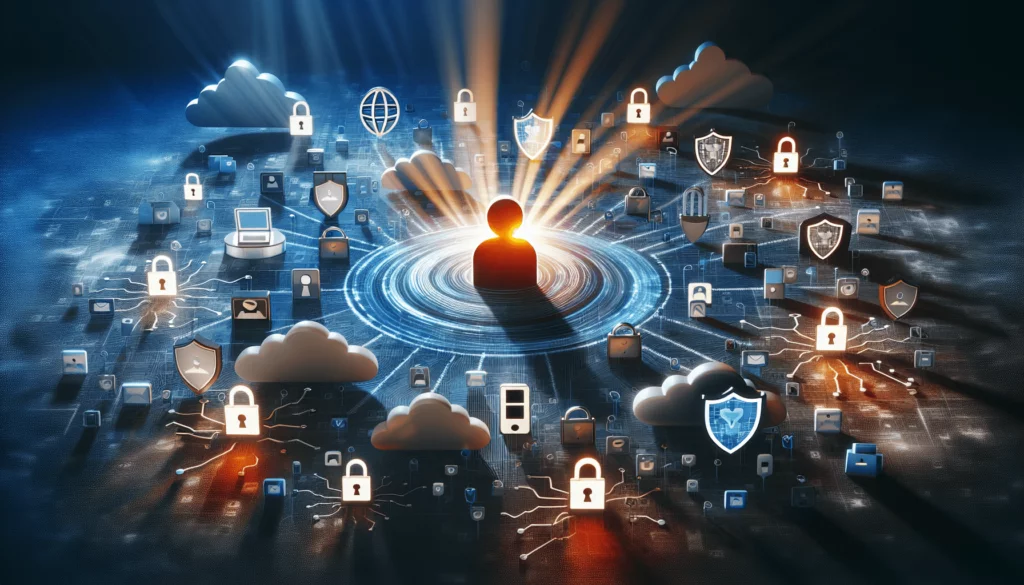
In today’s interconnected digital world, ensuring the security of your online identity has become a paramount concern. With the ever-increasing instances of data breaches and cyberattacks, protecting your personal information has never been more crucial. From safeguarding sensitive data to adopting strong password practices, this article explores effective strategies and practical tips to fortify your online identity, empowering you to confidently navigate the online landscape.
Creating Strong Passwords
Use a combination of letters, numbers, and symbols
When creating a password, it is essential to use a combination of letters, numbers, and symbols. This complexity makes it harder for hackers to guess or crack your password. Avoid using common words or phrases, as well as sequential or repetitive characters. Instead, opt for a mix of uppercase and lowercase letters, numbers, and special symbols to create a strong and secure password.
Avoid using personal information
Using personal information such as your name, date of birth, or address as part of your password is a security risk. Hackers can easily obtain this information through social engineering or data breaches. To protect your online accounts, refrain from using any personal details in your passwords.
Use a unique password for each online account
Using the same password for multiple online accounts is highly discouraged. If one of your accounts is compromised, hackers could potentially gain access to all of your accounts. To minimize this risk, it is crucial to create a unique password for each online account you have. This way, even if one account is compromised, your other accounts will remain secure.
Consider using a password manager
With the increasing number of online accounts we have, it can be challenging to remember unique and complex passwords for each one. This is where a password manager can be invaluable. A password manager securely stores all your passwords in an encrypted database, allowing you to generate strong passwords and automatically fill them in when needed. This not only simplifies the process but also enhances the security of your online accounts.
Enabling Two-Factor Authentication
What is two-factor authentication?
Two-factor authentication (2FA) is an additional layer of security that helps protect your online accounts. It requires two pieces of identification: something you know (such as a password) and something you possess (such as a unique code sent to your smartphone). This adds an extra level of protection, even if a hacker manages to obtain your password.
How does two-factor authentication work?
When you enable 2FA for an account, you will typically be asked to provide your phone number or use an authentication app. Once set up, whenever you log into your account, a unique code will be sent to your phone or generated by the app. You will need to enter this code along with your password to gain access. This ensures that even if someone has your password, they cannot log in without the additional code.
Finding online services that offer two-factor authentication
Many online services, including social media platforms, email providers, and banking institutions, offer two-factor authentication as an option. It is advisable to check the security settings of each account you use and enable 2FA whenever possible. This extra layer of security greatly reduces the risk of unauthorized access to your accounts.
Setting up two-factor authentication for your accounts
To set up 2FA, navigate to the security or account settings of the respective online service. Look for options related to two-factor authentication or multi-factor authentication. Follow the provided instructions to link your phone number or authentication app to your account. Once completed, make sure to test the functionality by logging out and logging back in to ensure the 2FA process is working correctly.



Being Cautious with Personal Information
Limit the amount of personal information shared online
One of the most effective ways to secure your online identity is by limiting the amount of personal information you share online. Avoid providing unnecessary information on social media platforms, public forums, or other online platforms. The less personal information available, the harder it is for malicious individuals to exploit it.
Be mindful of what you post on social media
Social media platforms can be a treasure trove of personal information if not used with caution. Be mindful of the content you post, keeping in mind that it may be accessible to a wide audience. Avoid sharing sensitive information such as your full address, phone number, or details about your daily routine. Regularly review your privacy settings and restrict the visibility of your posts to trusted contacts only.
Beware of phishing attempts and scams
Phishing attempts and scams are prevalent online, and being cautious is crucial for protecting your personal information. Be skeptical of unsolicited emails or messages asking for sensitive information, such as login credentials or financial details. Avoid clicking on suspicious links and verify the legitimacy of websites before providing any information. By being vigilant and wary of potential scams, you can avoid falling victim to identity theft or fraud.
Verify the security measures of websites before sharing personal information
Before sharing personal information, such as credit card details or your social security number, it is important to ensure that the website is secure and reputable. Look for indicators such as an SSL certificate, which is represented by a padlock icon in the browser’s address bar. Additionally, check the website’s privacy policy to understand how your data will be handled. Taking these precautions will minimize the risk of your personal information falling into the wrong hands.
Regularly Updating and Patching Software
Why is software updating important for online security?
Keeping your software, operating systems, and applications up to date is crucial for maintaining online security. Software updates often include security patches that address vulnerabilities found in previous versions. By regularly updating your software, you ensure that you have the latest security features and protection against emerging threats.
Configuring automatic updates on your devices
To simplify the process of updating your software, configure automatic updates on your devices. This ensures that you receive the latest updates without having to manually check for them. Most operating systems and applications have built-in options to enable automatic updates. By enabling this feature, you can ensure that your devices stay protected against potential security risks.
Patching vulnerabilities in software and applications
Apart from regular software updates, it is crucial to patch vulnerabilities as soon as they are discovered. Software vulnerabilities can be exploited by hackers to gain unauthorized access to your devices or personal information. Take time to review and apply patches released by software vendors promptly. Ignoring patches leaves your devices and personal data vulnerable to potential attacks.
Checking for updates in all installed programs
While it is important to update your operating system and commonly used applications, it is equally important to check for updates in all the programs installed on your device. This includes less frequently used applications and utilities. Outdated software can become an easy target for attackers, so regularly checking for updates and promptly installing them is essential.

Using Secure Wi-Fi Networks
Connecting to trusted and password-protected Wi-Fi networks
When connecting to Wi-Fi networks, prioritize trusted and password-protected networks. Public Wi-Fi networks, such as those available in coffee shops or airports, may lack proper security measures, making them susceptible to data interception by malicious individuals. Ensure the Wi-Fi network you connect to requires a password and has encryption enabled to safeguard your internet traffic.
Avoiding public Wi-Fi networks for sensitive transactions
While password-protected public Wi-Fi networks offer some level of security, it is still best to avoid performing sensitive transactions, such as online banking or shopping, on these networks. Hackers can potentially intercept your data, including login credentials or financial information. Instead, use a trusted cellular network or a secure Wi-Fi network that you have control over.
Using a VPN for additional security
A Virtual Private Network (VPN) adds an extra layer of security to your internet connection. When you use a VPN, your internet traffic is encrypted and routed through a server before reaching the intended destination. This makes it much more difficult for attackers to intercept or eavesdrop on your data. Consider using a reputable VPN service, especially when accessing the internet on public or unsecured networks.
Configuring Wi-Fi encryption on your home router
To ensure the security of your home Wi-Fi network, configure Wi-Fi encryption on your router. Use the latest encryption standard available, such as WPA3, which offers enhanced security compared to older encryption standards like WPA2. Additionally, change the default administrative credentials for your router, as attackers often target devices with default settings.
Regularly Monitoring and Reviewing Accounts
Checking account activity and statements regularly
Regularly monitoring your financial and online accounts is essential for identifying any unauthorized activities or suspicious transactions. Review your account statements, credit card bills, and other financial records regularly. If you notice any unfamiliar transactions or suspicious activities, report them to the respective financial institution or online service immediately.
Setting up alerts for suspicious activity
To stay proactive in protecting your accounts, set up alerts and notifications for suspicious activities. Many financial institutions and online services allow users to receive alerts for actions such as password changes, large transactions, or login attempts from unrecognized devices. By enabling these alerts, you can quickly take action in the event of any unauthorized access to your accounts.
Reviewing and analyzing credit reports
Monitoring your credit reports is an effective way to identify any potential signs of identity theft. Request a free copy of your credit report from each of the major credit bureaus at least once a year. Review the report for any inaccuracies, unfamiliar accounts, or suspicious inquiries. Promptly report any discrepancies to the credit bureau to rectify the situation.
Protecting your social security number and sensitive identification
Your social security number and other sensitive identification documents are valuable to identity thieves. Safeguard these documents by storing them in a secure location, such as a lockbox or a safe. Only provide your social security number when absolutely necessary, and be cautious when providing it online. Taking these precautions will minimize the risk of identity theft and unauthorized use of your personal information.

Securing Personal Devices
Using strong PINs, passwords, or biometric locks
Securing your personal devices with strong PINs, passwords, or biometric locks is crucial for protecting your online identity. Choose complex and unique combinations that are not easily guessable. Biometric locks, such as fingerprint or facial recognition, offer an additional layer of security. Use these features whenever available to add an extra level of protection.
Enabling remote tracking and device wiping
In the event that your device is lost or stolen, enabling remote tracking and device wiping capabilities can help protect your online identity. Many operating systems offer built-in features, such as Find My iPhone for iOS devices or Find My Device for Android devices. These features allow you to locate and remotely erase the data on your device to prevent unauthorized access.
Installing reputable antivirus and anti-malware software
To defend against malware and other online threats, it is imperative to install reputable antivirus and anti-malware software on your devices. Regularly update these software programs to ensure you have the latest virus definitions and protection against emerging threats. Perform regular scans of your devices to detect and remove any malicious software that may have been inadvertently downloaded.
Encrypting sensitive data on your devices
Encrypting sensitive data on your devices adds an extra layer of protection in case your device falls into the wrong hands. Most devices and operating systems offer built-in encryption features. Enable encryption for important files and sensitive data stored on your devices to prevent unauthorized access, even if the device is compromised.
Educating Yourself about Online Threats
Understanding common online threats and scams
To protect your online identity effectively, it is crucial to educate yourself about common online threats and scams. Stay informed about the various methods used by attackers to compromise personal information, such as phishing, spoofing, malware, and social engineering. By understanding these threats, you can recognize them and take appropriate measures to protect yourself.
Identifying phishing attempts and malicious websites
Phishing attempts and malicious websites are designed to trick users into revealing personal information or downloading malware. Learn to identify the signs of phishing, such as suspicious email addresses, generic greetings, or urgent requests for personal information. Be cautious while visiting websites and verify their legitimacy before entering any sensitive information. By being vigilant, you can avoid falling victim to these common tactics used by cybercriminals.
Staying updated on the latest security practices
As technology and online threats evolve rapidly, it is important to stay updated on the latest security practices. Follow reputable online security blogs, news outlets, and official websites to keep abreast of the latest security measures and best practices. Implement the recommended security practices to safeguard your online identity effectively.
Participating in online security courses or workshops
To deepen your knowledge of online security, consider participating in online security courses or workshops. These educational resources provide valuable insights into securing your online identity and offer practical tips on protecting personal information. By investing time in learning about online security, you enhance your ability to detect and mitigate potential threats.

Securing Social Media Accounts
Reviewing and updating privacy settings
Reviewing and updating your privacy settings on social media platforms is crucial for protecting your online identity. Restrict the visibility of your posts and personal information to trusted friends and connections only. Regularly review the privacy policy and settings of each platform to ensure you have control over who can access your information.
Being cautious of accepting friend requests from unknown individuals
Accepting friend requests from unknown individuals on social media can expose your personal information to potential risks. Be cautious and verify the identity and authenticity of the person before accepting their request. Avoid sharing personal information and engage with verified connections or trusted individuals only.
Avoiding oversharing personal information
Oversharing personal information on social media can leave you vulnerable to identity theft or social engineering attacks. Avoid posting sensitive information such as your full name, address, phone number, or financial details. It is important to strike a balance between sharing and maintaining your privacy to protect your online identity effectively.
Monitoring tagged posts and mentions
Monitor tagged posts and mentions on social media platforms to ensure that your online identity is not being misrepresented or used without your permission. Regularly review and control the posts in which you are tagged to prevent unauthorized associations or potential damage to your online reputation. Report any concerning or malicious content to the respective social media platform for removal.
Protecting Personal Data in the Cloud
Using strong, unique passwords for cloud accounts
Securing your personal data stored in the cloud starts with using strong and unique passwords for your cloud accounts. Avoid reusing passwords across multiple accounts and ensure that your cloud account password is complex and not easily guessable. Enable multi-factor authentication for an added level of protection.
Enabling two-factor authentication for cloud services
Enabling two-factor authentication (2FA) for your cloud services provides an additional layer of security. Similar to other online accounts, 2FA requires both a password and a secondary verification method, such as a unique code sent to your phone. This ensures that even if someone gains access to your password, they cannot log into your cloud account without the additional verification.
Encrypting sensitive files before uploading to the cloud
Before uploading sensitive files to the cloud, consider encrypting them to ensure their security. Encryption transforms your data into an unreadable format that can only be accessed with a decryption key or password. This provides an extra layer of protection in case your cloud account is compromised. Use reputable encryption software or services to encrypt your sensitive files before uploading them to the cloud.
Regularly backing up data stored in the cloud
While cloud storage offers convenience and accessibility to your data, it is important to regularly back up your data stored in the cloud. Accidental deletion, account compromise, or service disruptions can potentially lead to data loss. By regularly backing up your data, you ensure that even if something happens to your cloud storage, you have a secure backup.
In conclusion, securing your online identity requires a combination of proactive measures to protect personal information, adopt best practices, and use robust security measures. By following these guidelines, such as creating strong passwords, enabling two-factor authentication, being cautious with personal information, regularly updating software, using secure Wi-Fi networks, monitoring accounts, securing personal devices, educating yourself about online threats, protecting social media accounts, and safeguarding personal data in the cloud, you can enhance your online security and protect your online identity effectively. Remember, online security is an ongoing process that requires vigilance and regular review of your security practices.















